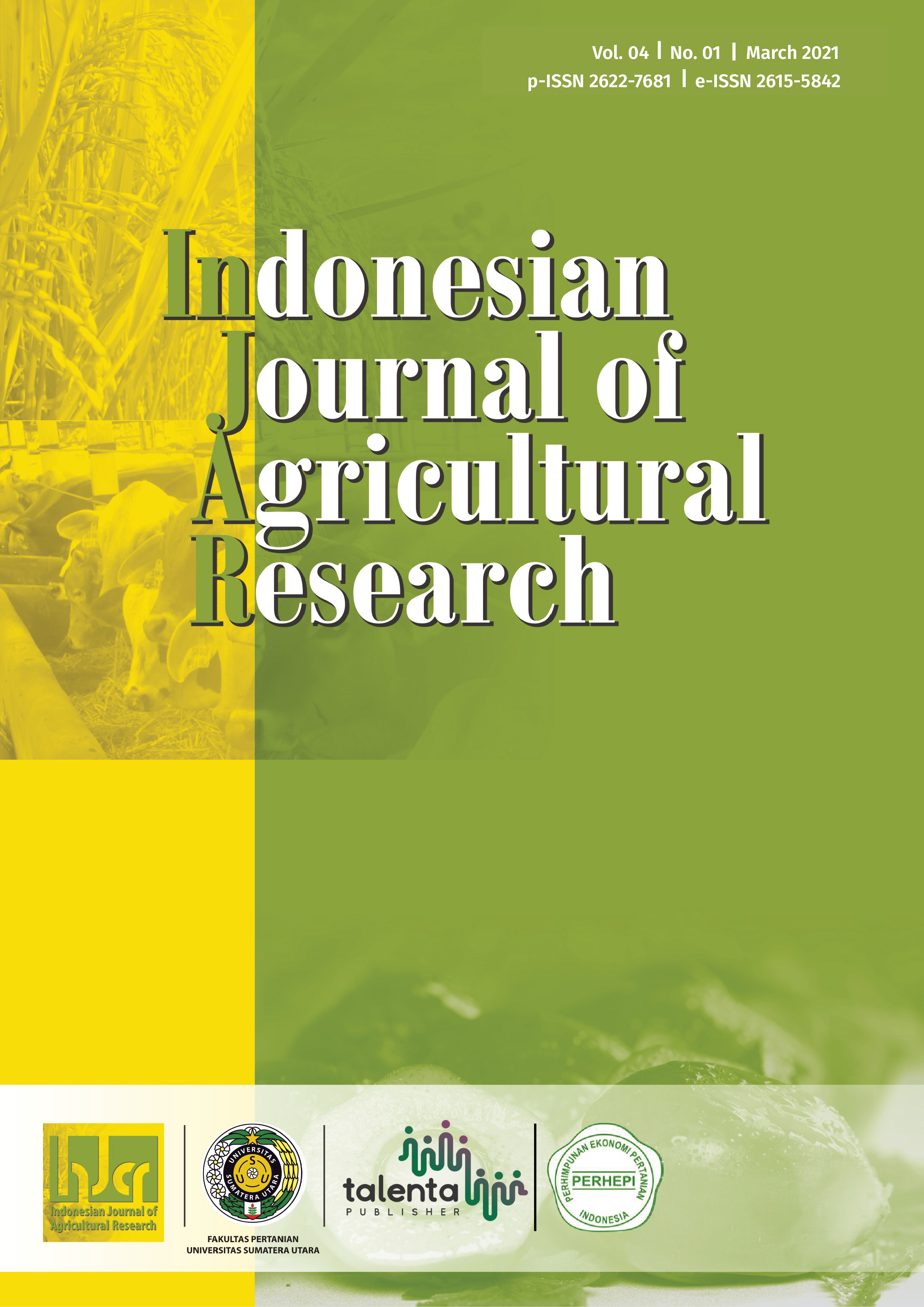Seroprevalence and Risk Factor Analysis of Hog Cholera Disease at Small Farm in Deli Serdang Regency
DOI:
https://doi.org/10.32734/injar.v4i1.5165Keywords:
hog cholera, pigs farm, prevalenceAbstract
Hog cholera is an epizootic viral diseases that attack pig. The disease is caused by Pestivirus C which belongs to the genus Pestivirus and the family Flaviviridae. Information about the prevalence and risk factors of hog cholera incidence in North Sumatra and especially in the Deli Serdang Regency became the basis for this research. This study aims to find out the prevalence and factors associated with seropositive hog cholera in Deli Serdang Regency. Samples were taken using a random sample technique with a simple random type. A total of 196 blood samples were collected from 8 sub-districts, 11 villages, and 54 farms in the Deli Serdang district. Animal and breeder data were collected with questionnaires to determine the incidence and causative factors of hog cholera seropositive. Data analysed using univariable and multivariable logistical regression tests to determine the association between hog cholera infection and risk factors. The results showed that the prevalence of Hog Cholera seroposive events at the agricultural level was 9% (5/54) and the individual rate was 10% (20/196). The results showed that the prevalence of Hog Cholera seroposive events at the agricultural level was 9% (5/54) and the individual rate was 10% (20/196). The conclusion of this research that the risk factors associated with pig cholera were landrace pigs (OR 14,28, 95% CI: 1.04-195) were more likely to have seropositif than other breeds and vaccination (OR 0.0048, 95% CI: 0.004-0.498) potential factors reducing hog cholera infection.
Downloads
References
N. R. Ichwanda, W. Lie, and S. G. Prakoso, “A Study about Pork Farm in Surakarta as Export Commodity,†Glob. Strateg., vol. 13, no. 1, pp. 123–132, 2019.
A. Postel et al., “Reemergence of classical swine fever, Japan, 2018,†Emerg. Infect. Dis., vol. 25, no. 6, p. 1228, 2019.
M. Woodford, “Office International des E pizooties: World Organization for Animal Health,†Encycl. Bioterrorism Def., 2005.
L. Ganges et al., “Classical swine fever virus: The past, present and future,†Virus Res., vol. 289, p. 198151, 2020.
P. M. Maranata, “FA-1 Case Study of Hog Cholera in Flores 2017 and Its Controlling,†Hemera Zoa, 2018.
E. A. A. Kusuma, “Prevalensi dan Faktor Risiko Seropositif Hog Cholera pada Babi di Kabupaten Sukoharjo,†Universitas Gadjah Mada, 2014.
A. Herawati, “Prevalensi Seropositif Hog Cholera Pascavaksinasi pada Babi di Kabupaten Karanganyar,†Universitas Gadjah Mada, 2014.
Y. Luo, S. Li, Y. Sun, and H.-J. Qiu, “Classical swine fever in China: a minireview,†Vet. Microbiol., vol. 172, no. 1–2, pp. 1–6, 2014.
R. Mappanganro, J. Syam, and C. Ali, “Tingkat Penerapan Biosekuriti Pada Peternakan Ayam Petelur Di Kecamatan Panca Rijang Kabupaten Sidrap,†J. ilmu dan Ind. Peternak., vol. 4, no. 1, pp. 60–73, 2019.
L. V. Alarcón, A. A. Alberto, and E. Mateu, “Biosecurity in pig farms: a review,†Porc. Heal. Manag., vol. 7, no. 1, pp. 1–15, 2021.
E. Leslie, “Formal pig movements across Eastern Indonesia–Risk for classical swine fever transmission,†2010.
A. Postel, V. Moennig, and P. Becher, “Classical swine fever in Europe—the current situation,†Berl Munch Tierarztl Wochenschr, vol. 126, no. 11–12, pp. 468–475, 2013.
B. A. Baldwin and D. B. Stephens, “The effects of conditioned behaviour and environmental factors on plasma corticosteroid levels in pigs,†Physiol. Behav., vol. 10, no. 2, pp. 267–274, 1973.
D. Smulders, G. Verbeke, P. Mormède, and R. Geers, “Validation of a behavioral observation tool to assess pig welfare,†Physiol. Behav., vol. 89, no. 3, pp. 438–447, 2006.
R. Larasati, “Pengaruh Stres pada Kesehatan Jaringan Periodontal,†J. Skala Husada J. Heal., vol. 13, no. 1, 2016.
I. R. Tizard, “Dendritic cells and antigen processing,†Vet. Immunol. An Introd., pp. 89–100, 2000.
K. Budiasa, “Titer Antibodi Hog Cholera Berbagai Tingkat Umur pada Ternak Babi,†Universitas Udayana.
S. Ivanyi, “Eradication of classical swine fever in Hungary.,†1977.
J. T. Van Oirschot, “Experimental production of congenital persistent swine fever infections: II. Effect on functions of the immune system,†Vet. Microbiol., vol. 4, no. 2, pp. 133–147, 1979.
A. Sarosa, I. Sendow, and T. Syafriati, “Pengamatan Status Kekebalan Terhadap Penyakit Hog Cholera Dengan Teknik Neutralization Peroxidase Linked Essay,†Balai Penelit. Vet., 2004.
S. Suradhat, S. Damrongwatanapokin, and R. Thanawongnuwech, “Factors critical for successful vaccination against classical swine fever in endemic areas,†Vet. Microbiol., vol. 119, no. 1, pp. 1–9, 2007.
Downloads
Published
How to Cite
Issue
Section
License
Copyright (c) 2021 Indonesian Journal of Agricultural Research

This work is licensed under a Creative Commons Attribution-ShareAlike 4.0 International License.



















